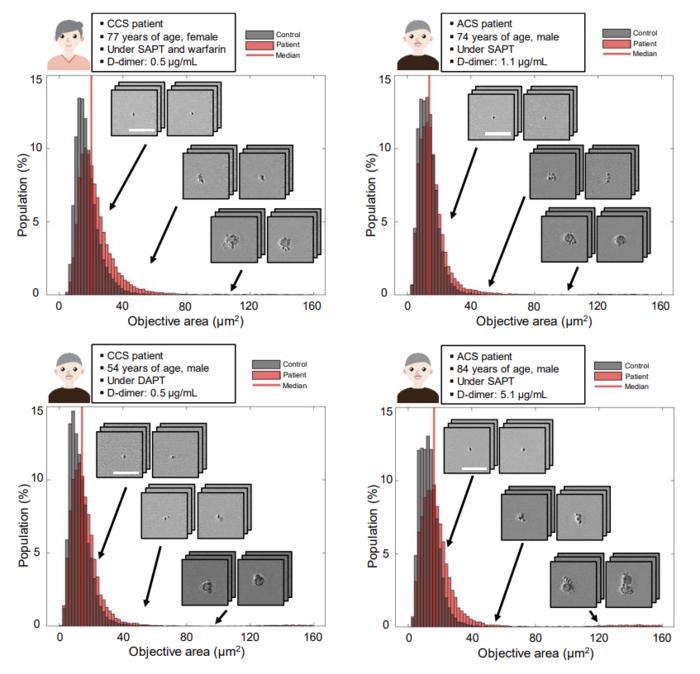Researchers at the University of Tokyo have pioneered a groundbreaking technique that allows real-time observation of platelet clumping in blood, offering critical insights into clot formation in patients with coronary artery disease (CAD). By harnessing the power of a state-of-the-art frequency-division multiplexed (FDM) microscope combined with advanced artificial intelligence (AI) analysis, their study introduces a non-invasive method poised to transform how clinicians assess clotting risk and tailor antiplatelet therapies for individuals suffering from heart disease.
Platelets, tiny but vital components in blood, act as first responders during vascular injury, aggregating rapidly to seal wounds and prevent excessive bleeding. However, in individuals with CAD, these platelets may go into overdrive, creating hazardous clots that block arterial blood flow, ultimately heightening the risk of heart attacks and strokes. Despite the importance of controlling platelet activity with antiplatelet drugs, doctors have long faced challenges in accurately measuring the effectiveness of these treatments on a patient-by-patient basis. This uncertainty leaves critical gaps in optimizing therapeutic interventions.
To tackle this issue, Dr. Kazutoshi Hirose and his team developed an innovative system that captures platelets in action with remarkable clarity and speed. At the heart of this innovation is an FDM microscope—a sophisticated optical device capable of taking thousands of high-resolution images of blood cells flowing through vessels every second. Unlike traditional microscopes, this technology moves beyond static imaging, effectively acting as a high-speed camera filming the dynamic interactions of cells in real-time.
Once the FDM microscope generates these rapid-fire images, the research team employs AI algorithms specifically trained to distinguish between individual blood components in motion. The AI is adept at recognizing solitary platelets, clusters of platelets, and even white blood cells, which can sometimes interact with or influence clot formation. This level of precise categorization is crucial, as the formation and size of platelet aggregates directly correlate with clotting risk and the severity of CAD symptoms.
The research, involving over 200 patients, revealed significant differences in platelet aggregation between those suffering from acute coronary syndrome and patients with more stable, chronic conditions. Acute patients exhibited markedly larger platelet clumps, a finding that aligns with heightened clotting risk and supports the technology’s potential as a predictive diagnostic tool. These insights underscore the capacity of this system to provide real-time clotting risk assessments, potentially enabling doctors to intervene more swiftly and with greater precision.
One of the most remarkable breakthroughs of the study is the discovery that simple venous blood draws from the arm deliver nearly the same valuable platelet activity information as blood sampled invasively from coronary arteries. Conventional methods require catheter insertion, a procedure that can be uncomfortable, risky, and resource-intensive. This less invasive approach promises to simplify monitoring protocols, lower patient risk, and broaden access to platelet activity testing in diverse clinical settings.
Dr. Hirose emphasized the clinical significance of these findings, highlighting that tailored therapy adjustments based on real-time platelet behavior could minimize both ischemic events caused by clots and bleeding complications associated with over-medication. This personalization aligns with the growing movement in medicine toward precision treatment, where therapies are fine-tuned according to individual patient profiles rather than a one-size-fits-all approach.
The underlying AI technology is a pivotal aspect of this research, offering capabilities far beyond human visual perception. AI’s ability to detect subtle patterns and fluctuations in platelet behavior within seconds makes it an invaluable partner in clinical diagnosis and drug efficacy evaluation. This harnessing of machine learning in biomedical imaging exemplifies the fusion of computational power and medical innovation, a trend likely to accelerate across many fields of healthcare.
Co-author Yuqi Zhou illustrated how the system mirrors traffic monitoring techniques, where a camera not only counts individual cars but also identifies traffic jams and emergency vehicles. In the bloodstream, single platelets are akin to individual cars, platelet clumps resemble traffic jams, and white blood cells are like police cars that can influence the scene. Such analogies help conceptualize the complexity and high-resolution detection capacity of the technology.
Professor Keisuke Goda, the project’s lead, reflected on the transformative potential of combining high-speed optical imaging with AI, stressing how these advances allow unprecedented observation of blood cells in their natural flowing state. This approach shatters previous limitations of static slide samples or indirect testing, opening new avenues for real-time blood analysis and cardiovascular risk assessment.
Beyond CAD, the implications for this technology could extend to other disorders involving abnormal blood clotting, including stroke, deep vein thrombosis, and certain inflammatory diseases. By providing a window into the microscopic blood traffic with fine detail and speed, this FDM microscope and AI system might redefine both diagnostics and the monitoring of therapeutic responses in various hematologic conditions.
Looking forward, the researchers aim to integrate this technology into clinical workflows, enabling more frequent and less invasive monitoring of at-risk patients. The ultimate vision is a new standard of care where personalized antiplatelet treatments are dynamically adjusted based on continuous or periodic direct observation of platelet behavior, enhancing both safety and efficacy.
This study, published in Nature Communications, underscores the power of interdisciplinary collaboration—melding optics, machine learning, and clinical medicine—to address longstanding challenges in cardiovascular health. It stands as a compelling example of how emergent technologies can reveal hidden physiological stories that ultimately improve patient outcomes and save lives.
Subject of Research: Human tissue samples
Article Title: Direct evaluation of antiplatelet therapy in coronary artery disease by comprehensive image-based profiling of circulating platelets
News Publication Date: 15-May-2025
Web References: http://dx.doi.org/10.1038/s41467-025-59664-8
References: Kazutoshi Hirose et al., Nature Communications, 2025
Image Credits: ©2025 Hirose et al CC-BY-ND
Keywords: platelet aggregation, coronary artery disease, FDM microscope, artificial intelligence, antiplatelet therapy, high-speed imaging, blood clotting, cardiovascular risk, non-invasive diagnostics, real-time monitoring
Tags: advanced artificial intelligence in medicinebreakthroughs in cardiovascular researchcoronary artery disease researchfrequency-division multiplexed microscopyheart disease treatment innovationsnon-invasive clotting risk assessmentoptimizing therapeutic interventionspersonalized antiplatelet therapyplatelet activity monitoringprevention of heart attacks and strokesreal-time platelet aggregation observationUniversity of Tokyo medical advancements





